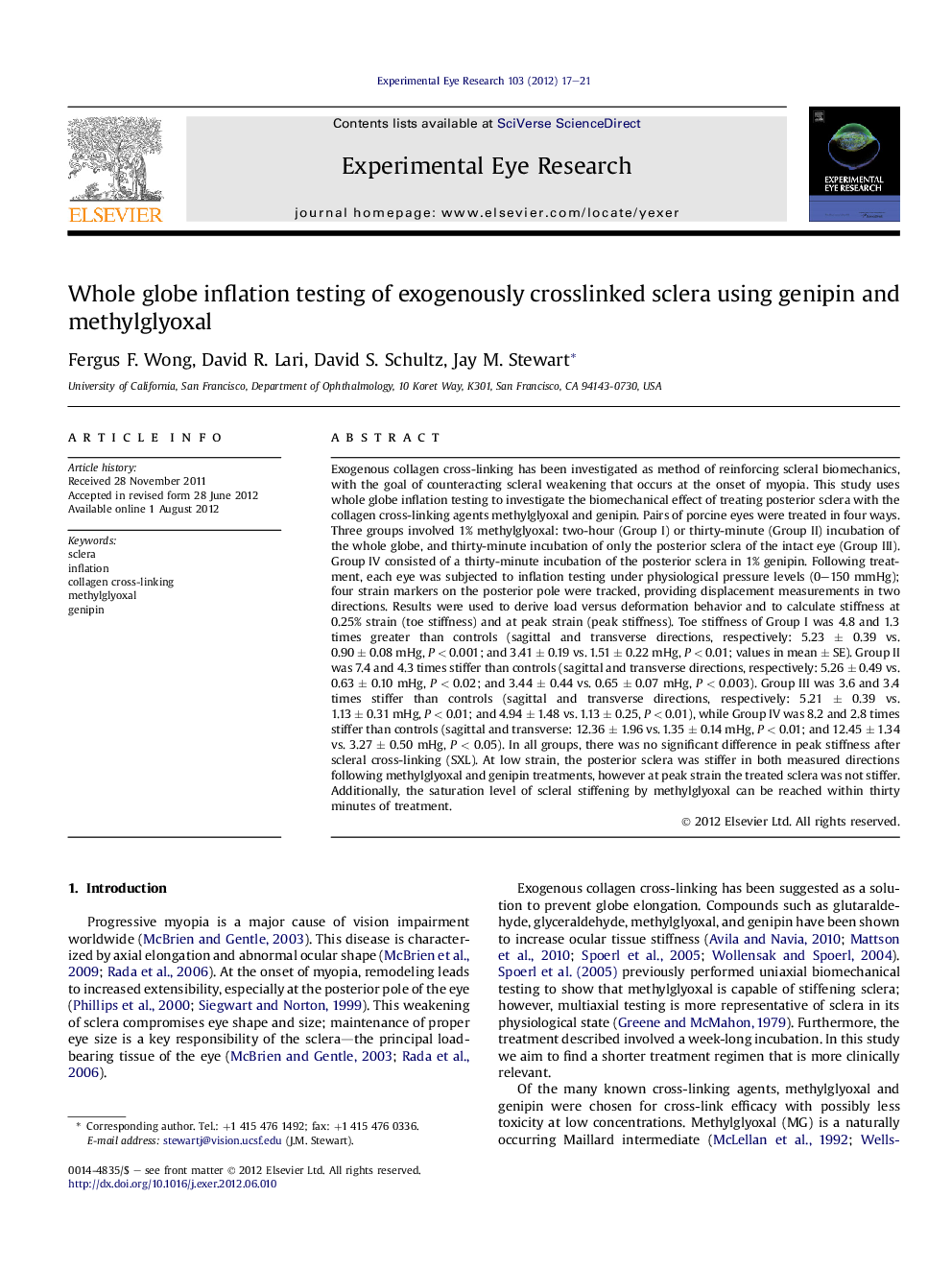| کد مقاله | کد نشریه | سال انتشار | مقاله انگلیسی | نسخه تمام متن |
|---|---|---|---|---|
| 4011276 | 1602619 | 2012 | 5 صفحه PDF | دانلود رایگان |

Exogenous collagen cross-linking has been investigated as method of reinforcing scleral biomechanics, with the goal of counteracting scleral weakening that occurs at the onset of myopia. This study uses whole globe inflation testing to investigate the biomechanical effect of treating posterior sclera with the collagen cross-linking agents methylglyoxal and genipin. Pairs of porcine eyes were treated in four ways. Three groups involved 1% methylglyoxal: two-hour (Group I) or thirty-minute (Group II) incubation of the whole globe, and thirty-minute incubation of only the posterior sclera of the intact eye (Group III). Group IV consisted of a thirty-minute incubation of the posterior sclera in 1% genipin. Following treatment, each eye was subjected to inflation testing under physiological pressure levels (0–150 mmHg); four strain markers on the posterior pole were tracked, providing displacement measurements in two directions. Results were used to derive load versus deformation behavior and to calculate stiffness at 0.25% strain (toe stiffness) and at peak strain (peak stiffness). Toe stiffness of Group I was 4.8 and 1.3 times greater than controls (sagittal and transverse directions, respectively: 5.23 ± 0.39 vs. 0.90 ± 0.08 mHg, P < 0.001; and 3.41 ± 0.19 vs. 1.51 ± 0.22 mHg, P < 0.01; values in mean ± SE). Group II was 7.4 and 4.3 times stiffer than controls (sagittal and transverse directions, respectively: 5.26 ± 0.49 vs. 0.63 ± 0.10 mHg, P < 0.02; and 3.44 ± 0.44 vs. 0.65 ± 0.07 mHg, P < 0.003). Group III was 3.6 and 3.4 times stiffer than controls (sagittal and transverse directions, respectively: 5.21 ± 0.39 vs. 1.13 ± 0.31 mHg, P < 0.01; and 4.94 ± 1.48 vs. 1.13 ± 0.25, P < 0.01), while Group IV was 8.2 and 2.8 times stiffer than controls (sagittal and transverse: 12.36 ± 1.96 vs. 1.35 ± 0.14 mHg, P < 0.01; and 12.45 ± 1.34 vs. 3.27 ± 0.50 mHg, P < 0.05). In all groups, there was no significant difference in peak stiffness after scleral cross-linking (SXL). At low strain, the posterior sclera was stiffer in both measured directions following methylglyoxal and genipin treatments, however at peak strain the treated sclera was not stiffer. Additionally, the saturation level of scleral stiffening by methylglyoxal can be reached within thirty minutes of treatment.
► The study evaluates scleral mechanics in porcine eyes after cross-linking (SXL).
► Whole globe inflation testing confirms posterior stiffening with 30-min. treatment.
► Treatment of the posterior sclera alone is equivalent to whole eye treatment.
► Provides support for in vivo testing of posterior SXL for progressive myopia.
Journal: Experimental Eye Research - Volume 103, October 2012, Pages 17–21